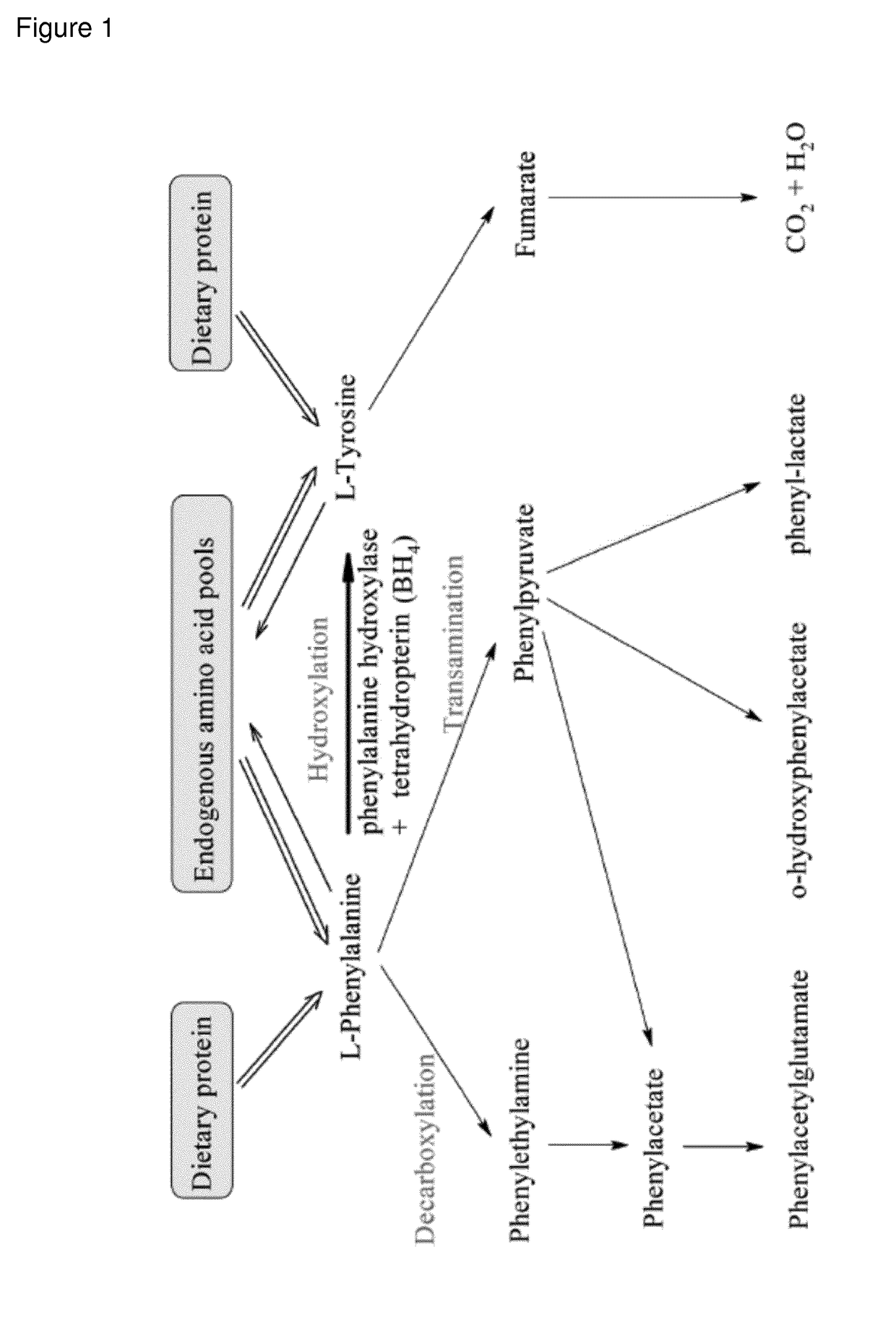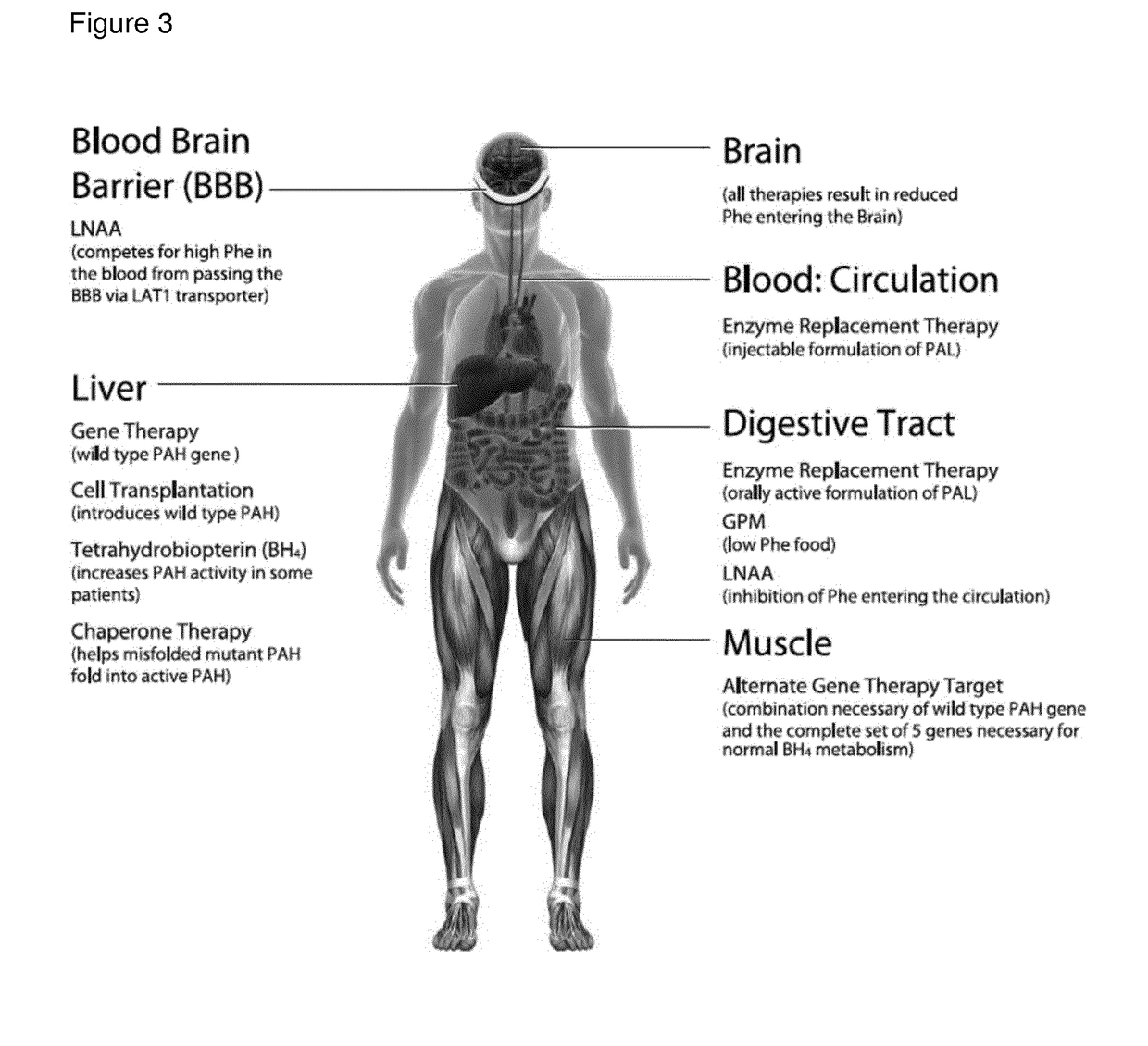Recombinant phe-free proteins for use in the treatment of phenylketonuria
- Summary
- Abstract
- Description
- Claims
- Application Information
AI Technical Summary
Benefits of technology
Problems solved by technology
Method used
Image
Examples
specific embodiments
[0162]Embodiments of the invention appear from the appended claims, which hereby are included in the present description of the invention.
[0163]In particular the invention also relates to the specific method:
[0164]A method of generating a recombinant microorganism comprising a nucleic acid sequence mutated to be Phe-free or Phe-low (without Phe content or with at the most 40% Phe content, calculated as number of aa compared with total number) comprising the steps:[0165]i. Making phe-specific mutations in said nucleic acid sequence using site directed mutagenesis to replace single Phe codons with single LNAA codons,[0166]ii. Restriction enzyme (Dpnl) removal and purification of the mutated nucleic acid sequence followed by ligation into a temperature-sensitive vector capable of initiating rolling circle recombination at introduced homologous gene fragments from a Bacillus final production strain (CICC10266) at temperatures of 42° C. or greater and carrying a gene conferring kanamycin...
example 1
[0282]Proteins with Less Phe Contents From Bacillus and Human
[0283]From available published information, proteins No. 1 to 10 from B. subtilis, No. 11 from human, No. 12 and 13 from B. licheniformis have been selected for expression based on their Phe contents or high expression level in its native host (Table 2).
TABLE 2Proteins selected for recombinant expressionin B. subtilis and B. licheniformis.NumberofSe-Abbrevi-aminoNumberquenceationFull nameacidsof PheID NO*ΔPro1minor extracellular protease epr2243No. 1region 135-358ΔPro2minor extracellular protease vpr1833No. 2region 180-362ΔamyQalpha-amylase region 59-2391816No. 3ΔyjeAsecreted deoxyriboendonuclease1883No. 4region 274-461estAsecreted alkaliphilic lipase1814No. 5estBsecreted esterase / lipase1823No. 6aprEserine alkaline protease2753No. 7amyEalpha-amylase61822No. 8amyLalpha-amylase48320No. 9nprEextracellular neutral3019No. 10metalloproteaseALABhuman alpha-lactalbumin1234No. 11BIapralkaline protease2743No. 12liplipase1743No. 13EG...
example 2
References for Example 2
[0318][1] Gang-Ping Xue, Jennifer S. Johnson, Brian P. Dalrymple. High osmolarity improves the electro-transformation efficiency of the gram-positive bacteria Bacillus subtilis and Bacillus licheniformis, Journal of Microbiological Methods, 1999, 34(3):183-191.
[0319][2] Bradford M M. A rapid and sensitive method for the quantitation of microgram quantities of protein utilizing the principle of protein-dye binding. Anal Biochem, 1976, 72:248-254.
PUM
| Property | Measurement | Unit |
|---|---|---|
| Fraction | aaaaa | aaaaa |
| Fraction | aaaaa | aaaaa |
| Fraction | aaaaa | aaaaa |
Abstract
Description
Claims
Application Information
 Login to View More
Login to View More - R&D
- Intellectual Property
- Life Sciences
- Materials
- Tech Scout
- Unparalleled Data Quality
- Higher Quality Content
- 60% Fewer Hallucinations
Browse by: Latest US Patents, China's latest patents, Technical Efficacy Thesaurus, Application Domain, Technology Topic, Popular Technical Reports.
© 2025 PatSnap. All rights reserved.Legal|Privacy policy|Modern Slavery Act Transparency Statement|Sitemap|About US| Contact US: help@patsnap.com



